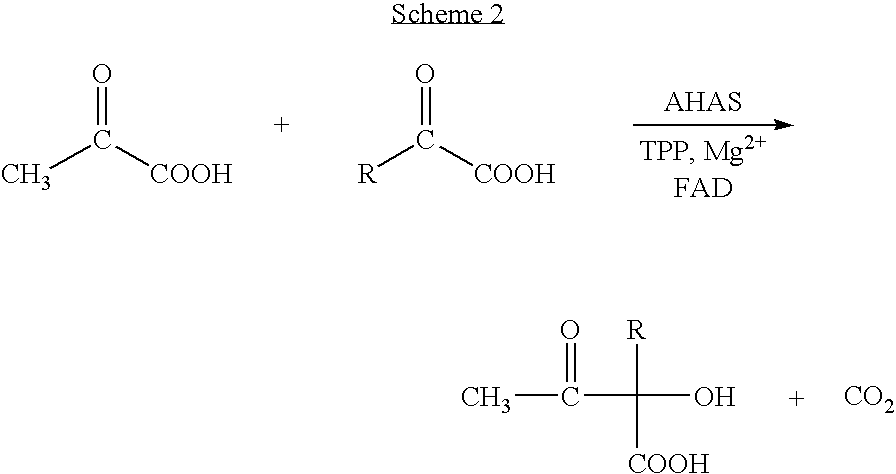Process for preparing chiral aromatic alpha-hydroxy ketones using 2-hydroxy-3-oxoacid synthase
a technology of hydroxy ketone and 2-hydroxy-3-oxoacid synthase, which is applied in the field of biotransformation process for preparing chiral aromatic hydroxy ketone, can solve the problems of reducing the yield of the target product, affecting the purification process, and limiting the above-process process
- Summary
- Abstract
- Description
- Claims
- Application Information
AI Technical Summary
Benefits of technology
Problems solved by technology
Method used
Image
Examples
example 1
[0043] A 1 ml quartz cuvette containing 1 ml of the reaction mixture containing 5 mM of sodium pyruvate and 5 mM of benzaldehyde, in a reaction buffer contained 0.1 M Tricine-HCl, pH 7.5, 1 mM MgCl2, 60 mM KCl, 0.1 mM TPP, and 0.05 mM FAD, was placed in the spectrophotometer at 37° C. Reaction was started by addition of 10 μl of an AHAS isozyme II solution containing 33 mg enzyme / ml. The absorbance value at 302 nm decreased linearly at a rate of 0.161 OD / min, which yielded a decrease of benzaldehyde concentration of 0.36 μmol / min, when using ε=454 M−1cm−1. The corresponding activity was 1.07 U / mg.
example 2
[0044] The reaction rate was measured as described in Example 1, using as substrates 5 mM pyruvate and 5 mM 3-hydroxybenzaldehyde. The absorbance values at 346 nm decreased linearly at a rate of 0.15 OD / min, which yielded a decrease of hydroxybenzaldehyde concentration 0.3 μmol / min, when using ε=480 M−1cm−1. The corresponding activity was 0.93 U / mg.
example 3
[0045] Two 20 ml flasks, each containing ten ml of the reaction mixture as described above in the paragraph Biotransformation, were shaken at 30° C. One of the flasks contained substrates at the concentrations of 10 mM, the other one of 30 mM. The reaction started by addition of 3 mg of AHAS isozyme II, and was ended after 1 h by adding 10 ml diethyl ether, and extracting, followed by second extraction with 10 ml. The extract was dried as described, evaporated to completely remove solvent and redissolved in dichloromethane. This sample was analyzed by GC-MS and GLC using FID detection. Mass spectrum showed three components corresponding to phenylacetyl carbinol (PAC), 2-hydroxypropiophenone (2-HPP), and phenylpropanedione (PPD). The following table shows the relative areas corresponding to the three products by FID.
TABLE 2GLC, FID detector, % areas.SubstratesPAC2-HPPPPD10 mM8015530 mM>99not detectablenot detectable
PUM
| Property | Measurement | Unit |
|---|---|---|
| Temperature | aaaaa | aaaaa |
| Temperature | aaaaa | aaaaa |
| Fraction | aaaaa | aaaaa |
Abstract
Description
Claims
Application Information
 Login to View More
Login to View More - R&D
- Intellectual Property
- Life Sciences
- Materials
- Tech Scout
- Unparalleled Data Quality
- Higher Quality Content
- 60% Fewer Hallucinations
Browse by: Latest US Patents, China's latest patents, Technical Efficacy Thesaurus, Application Domain, Technology Topic, Popular Technical Reports.
© 2025 PatSnap. All rights reserved.Legal|Privacy policy|Modern Slavery Act Transparency Statement|Sitemap|About US| Contact US: help@patsnap.com



